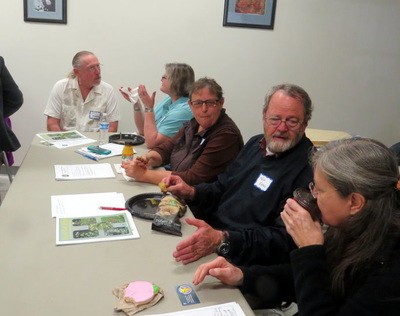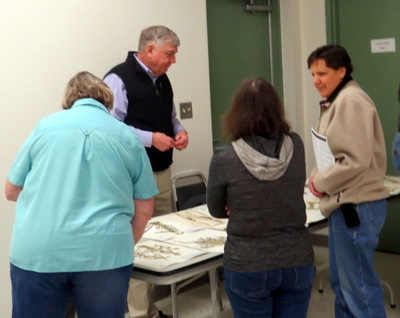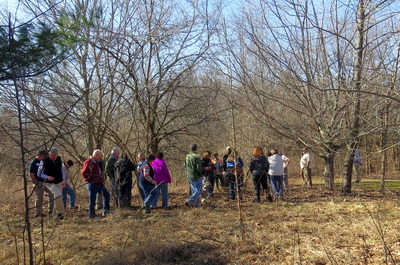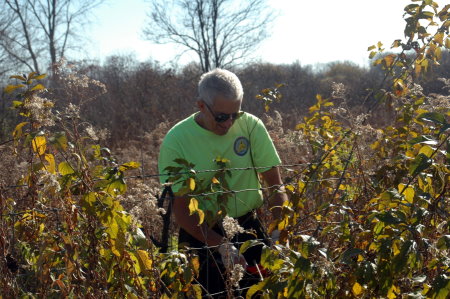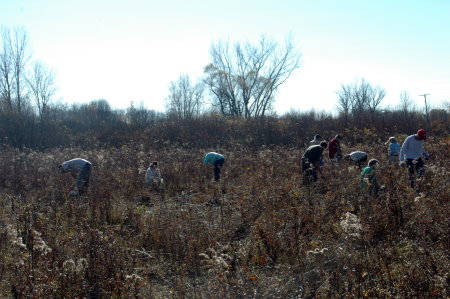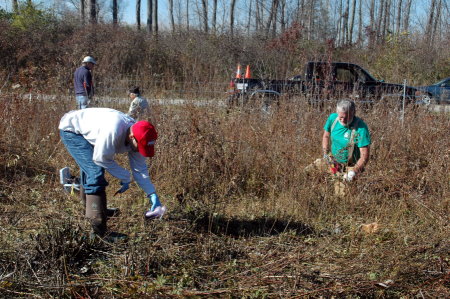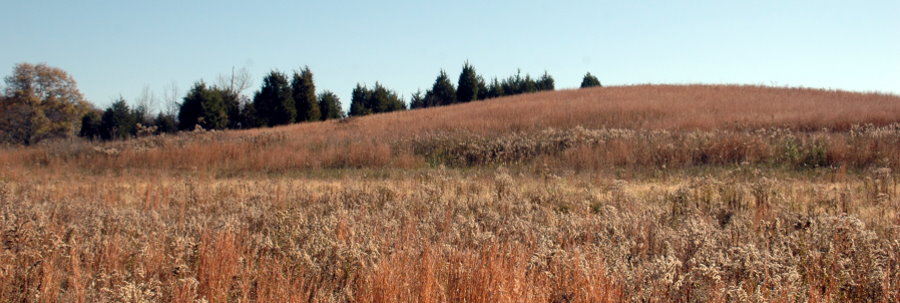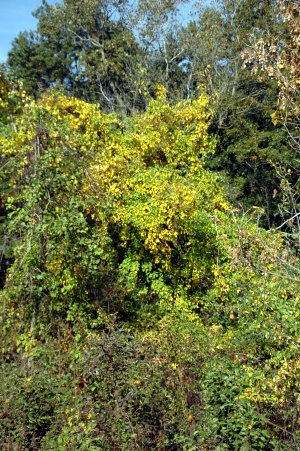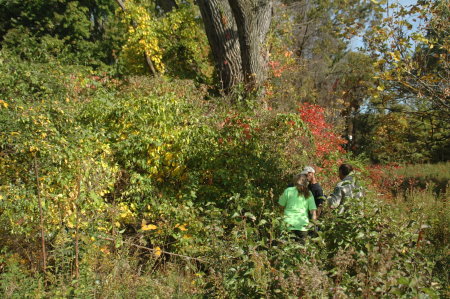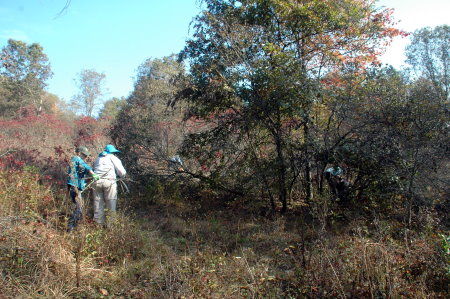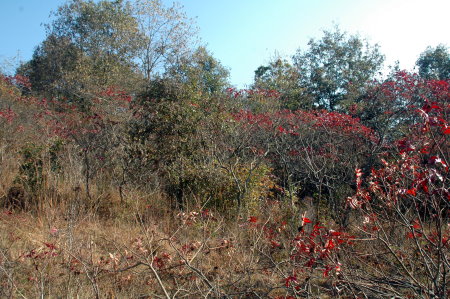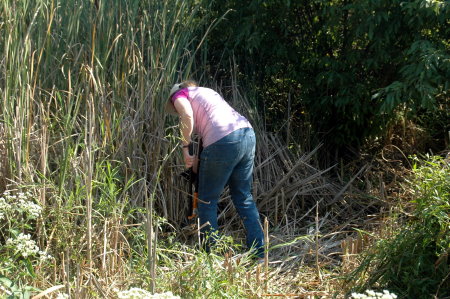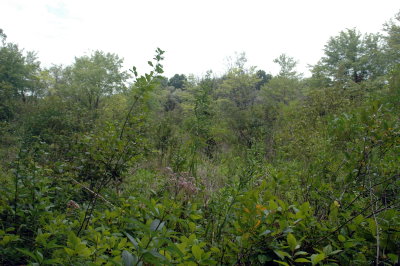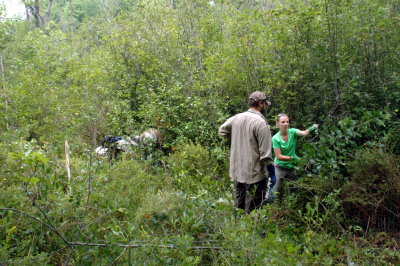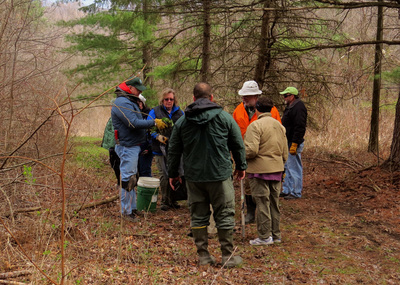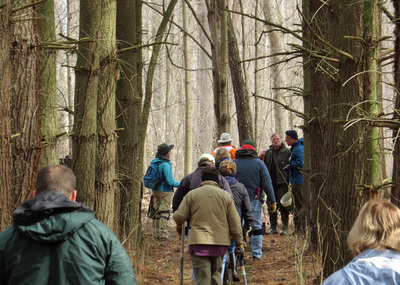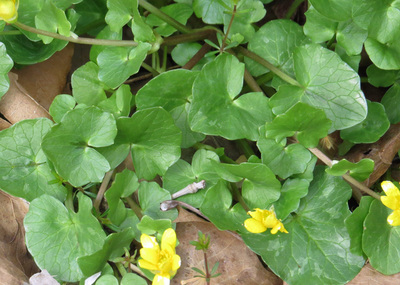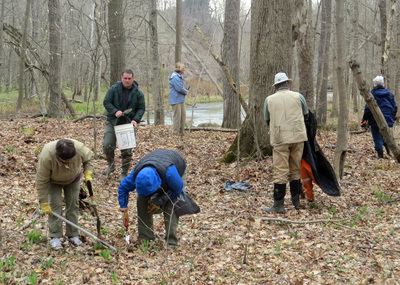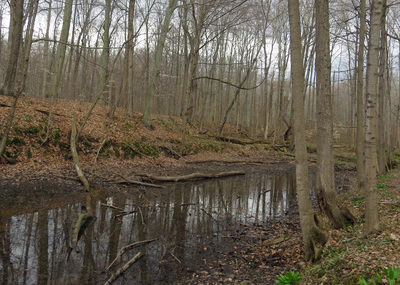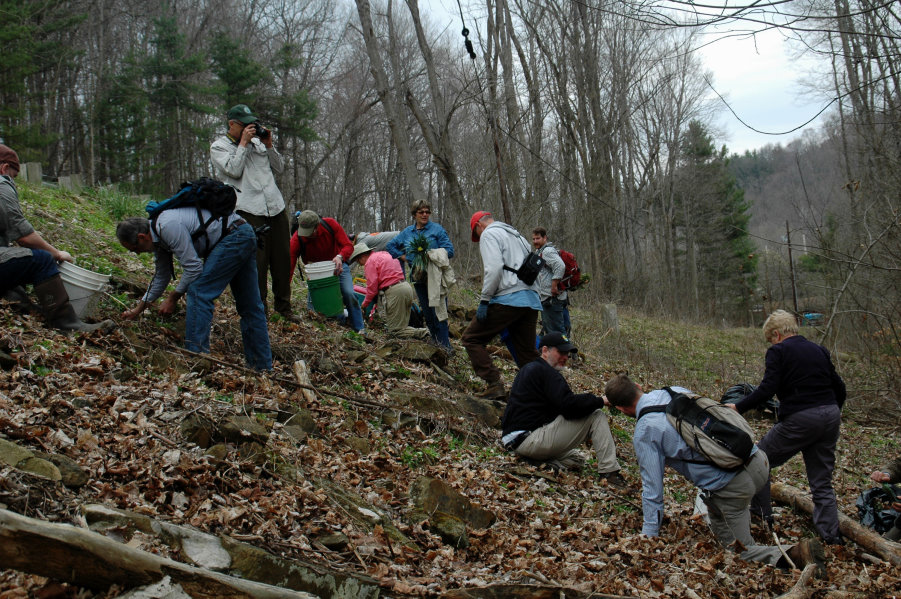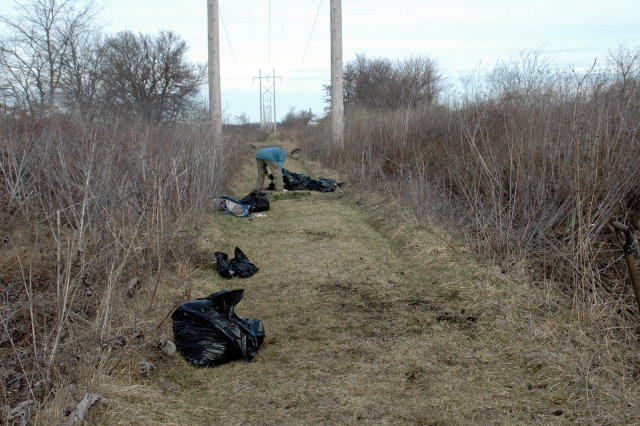2016 ONAPA STEWARDSHIP PROJECT REPORTS
ONAPA Volunteer Stewardship Training, a Great Success!
Thanks for joining us!
Saturday, February 20, 2016 from 10 a.m. -3 p.m.
Stages Pond State Nature Preserve
4792 Hagerty Road, Ashville, OH 43103
Download Training Agenda HERE.
Stages Pond State Nature Preserve
4792 Hagerty Road, Ashville, OH 43103
Download Training Agenda HERE.
Stewards at Dayton Medway Site
On November 17th, we had a record number of 19 volunteers and staff working at the Medway site for Eastern prairie fringed orchid in Clark County. There were 13 ONAPA volunteers, 4 DNAP staff, and 2 USFWS staff working on land owned by the City of Dayton to manage habitat for the federally threatened prairie fringed orchid. Habitat management has been conducted here by DNAP and USFWS for many years in cooperation with the City of Dayton, but the site was growing up in thick shrubs, so ONAPA was willing to help. We cut and treated multiflora rose, Amur honeysuckle, willows, and dogwoods. Some of the larger stems were hauled from the meadow and chipped in a chipper provided by DNAP. It was a very successful day and we look forward to a good response next year by the orchids!
Chaparral Praire State Nature Preserve Invasive Shrub Control
On Saturday, November 12th, 4 ONAPA volunteers and 2 DNAP staff worked for 4 hours cutting and treating autumn-olive at Chaparral Prairie State Nature Preserve in Adams County. We worked on the new parcel at the preserve in a section that is slowly establishing into prairie. Autumn-olive has established itself in this area and we were determined to eradicate it to promote the prairie plants. DNAP staff have worked hard on this parcel to open up the prairie areas and this was one area that preserve manager, Josh Deemer wanted to control the invading autumn-olive.
Bonnett Pond Bog State Nature Preserve Stewards in Action!
|
|
On November 2nd, 7 ONAPA volunteers worked with Rick Gardner from DNAP to remove invasive woody species around the bog at Bonnett Pond Bog State Nature Preserve in Holmes County. It was a beautiful November day; we cut and treated multiflora rose, Amur honeysuckle, Japanese barberry, and privet in the surrounding woods. The moat around the bog was too deep to access the bog at this time of year, but there were plenty of invasives to control in the vicinity of the bog. The Japanese barberry and privet were particularly disturbing as there were so many shrubs in the understory.
|
Campbell Preserve Stewardship Project
Five (5) ONAPA volunteers and 3 DNAP staff worked together on Wednesday, October 19th at Campbell Preserve in the Oak Openings to control a number of invasive plants. While Campbell Preserve hosts over 40 state-listed rare plants, there are many invasive plants threatening this unique combination of sand dune and wet sedge meadow habitats. The crew cut and treated oriental bittersweet, multiflora rose, autumn-olive, black alder, glossy and common buckthorn. After lunch, the group went on a short hike and were able to see a few of the rare plants found at this preserve, such as fringed gentian and soapwort gentian in flower. It was a beautiful fall day and we had a sense of accomplishment controlling so many invasives!
Woody Species Removal Stewardship Project at Brinkhaven Oak Barrens
|
Before:
|
Fourteen (14) volunteers from ONAPA and the Killbuck Watershed Land Trust (KWLT) worked tirelessly together on Saturday, October 15th to begin restoration in the north barrens at Brinkhaven Oak Barrens in Holmes County. There were 6 people from ONAPA and 8 people from the KWLT, including 7 members of Don Beam's family. Don Beam dedicated many years of his life to acquiring, protecting, and managing this amazing site, leaving us all a legacy when he passed away unexpectedly in January 2013. The north barren was getting very overgrown, so we used chainsaws and loppers to cut out sumac, hawthorns, aspen, and cherry, then treated the cut stems with herbicide to prevent re-sprouting. This restoration should improve habitat for the prairie grasses and forbs in this opening.
|
After:
|
Glossy Buckthorn Removal Stewardship Project at Kent Bog State Nature Preserve
On Wednesday, October 5th, 21 people including 2 DNAP staff, 13 ONAPA volunteers, and 6 Student Conservation Association (SCA) staff worked at Kent Bog to remove glossy buckthorn seedlings and saplings that were invading the bog. Many small buckthorns are present in the understory of the bog, beneath the highbush blueberry shrubs and tamarack trees. To minimize herbicide use in the sensitive bog mat, the most effective method to remove the small buckthorns is hand-pulling. SCA staff cut and treated the larger buckthorns to eliminate fruit production. SCA is funded by a GLRI (Great Lakes Restoration Initiative) grant for the Crooked River CWMA (Cooperative Weed Management Area) and has been working on invasive plant control in several natural areas in NE Ohio. We were happy to have their assistance. After lunch, preserve manager Adam Wohlever led a short interpretive hike along the boardwalk so participants could see many of the unique bog plants. Former preserve manager, Emliss Ricks also attended and helped which was a very welcome surprise!
Invasive Species Removal Stewardship Project at Prairie Road Fen State Nature Preserve
A great partnership project between ONAPA, DNAP, Army Corps of Engineers (COE), and Beaver Creek Wetlands occurred on September 20th at Prairie Road Fen in Clark County. With at least 19 people, including 7 from the COE, 5 from DNAP, 1 from Beaver Creek Wetlands, and 6 ONAPA volunteers, we worked together for several hours on another hot day to cut and treat many stems of glossy buckthorn in the fen meadows of this high-quality prairie fen. The site is owned by the COE, so it was wonderful to have COE staff working with DNAP staff and ONAPA volunteers to make progress on removing this very invasive, non-native shrub in the meadows. The project included a short hike with former preserve manager, Tim Snyder to interpret the significant geologic, ecological, and botanical features of the preserve.
Invasive Species Control Stewardship Project at Springville Marsh State Nature Preserve
Despite serious heat and humidity, 4 ONAPA volunteers and 2 DNAP staff worked at Springville Marsh on September 7th to control invading plants in the sedge meadows. We cut and treated narrow-leaved cattail, dogwoods, and willows, and even cut down a red maple tree. There is plenty more to do to maintain the sedge meadows at this wetland preserve, so we may schedule another day on a cooler day this fall!
GALLAGHER FEN INVASIVE CONTROL STEWARDSHIP PROJECT
On Wednesday, August 24th, 9 ONAPA volunteers and 3 DNAP staff worked together at Gallagher Fen to remove woody species on the west hillside above one of the fen meadows. This hillside has many prairie and savanna plants, but the woody species have encroached significantly in recent years. The group cut and treated autumn-olive, oaks, bush honeysuckle, and Asian bittersweet on the hillside. The Asian bittersweet was particularly challenging to remove! After lunch, former preserve manager (for west-central Ohio), Tim Snyder (now one of ONAPA's stewardship project coordinators) gave an excellent tour of the west fen about its geology, history, and fen ecology.
JACKSON BOG INVASIVE CONTROL STEWARDSHIP PROJECT
On Saturday, August 20th, 8 ONAPA volunteers and 3 DNAP staff worked together to remove invasive plants from several fen meadows at Jackson Bog (actually a fen). Despite the heat and humidity, the crew accomplished a lot by removing and treating purple loosestrife, narrow-leaved cattail, glossy and common buckthorn, privet, Asian bittersweet, and small-flowered willow-herb. The project included a short tour to see some of the unusual fen plants, led by preserve manager, Adam Wohlever.
MYERSVILLE FEN WOODY INVASIVE CONTROL STEWARDSHIP PROJECT
Despite the heat and humidity, 5 ONAPA volunteers and 3 DNAP staff worked at Myersville Fen State Nature Preserve on August 10th to control invading woody species in the fen meadows. These species included glossy buckthorn, alder, and ninebark, as well as some hairy willow-herb. The small fen meadows contain many rare and unusual plants which require open meadows, so the encroaching woody species threaten to shade them out. The woody species were cut and treated with herbicide, while the hairy willow-herb was pulled out and removed from the meadows.
JOHNSON WOODS INVASIVE WOODY CONTROL
On Saturday, July 20th, nine ONAPA volunteers and two DNAP staff worked on another hot, humid day at Johnson Woods to control invasive shrubs, including burning-bush (also known as winged euonymus), Japanese barberry, and multiflora rose. A small patch of Japanese knotweed was also cut and treated with herbicide. Johnson Woods is a high-quality mature oak-hickory woods, so controlling invasive shrubs in the understory is critical to maintaining spring and other herbaceous wildflowers. Many large burning-bush were cut and treated on the south edge of the north woods along Fox Lake Road. Volunteers enjoyed an awe-inspiring hike along the boardwalk in the southern section after lunch, amazed by the size of the large red and white oaks.
BUSH HONEYSUCKLE REMOVAL PROJECT AT CLIFTON GORGE
|
A hardy crew of 17 including ONAPA volunteers, Dawes Arboretum Residents, and DNAP staff worked at Clifton Gorge on July 13th to control invasive woody shrubs on the scientific side of the preserve. It was a long walk to this section of the preserve on a hot, humid day. They were able to remove and treat invasive shrubs such as Amur bush honeysuckle, privet, and burning bush. This habitat management is important as many rare plants occur on the scientific side such as red baneberry. Volunteers got a tour of the preserve by preserve manager, Michelle Comer after working for several hours.
About Clifton Gorge State Nature Preserve. . .
This 268-acre preserve protects one of the most spectacular dolomite and limestone gorges in the state. Registered as a National Natural Landmark in 1968, Clifton Gorge encompasses a 2-mile stretch of the Little Miami State and National Scenic River, just east of John Bryan State Park. Geologically, it is an outstanding example of interglacial and post-glacial canyon cutting. At one point, the river funnels through a deep, narrow channel, which was apparently formed by the enlarging and connecting of a series of potholes in the resistant Silurian dolomite bedrock. In other sections of the gorge, cliff overhangs have broken off forming massive slump blocks scattered along the valley floor. |
DAUGHMER PRAIRIE SAVANNAH TEASEL REMOVAL PROJECT
ONAPA held another stewardship project at Daughmer Savannah in Crawford County on June 18, 2016 in cooperation with Crawford County Park District. There were 12 ONAPA volunteers and 7 Park District volunteers who worked to pull or dig common teasel and Canada thistle in the savanna. This combined with the recent prescribed burns has helped the savanna to look spectacular this year, with many new prairie plants emerging! Volunteers got a tour of the savanna at the end of the day, including a walk back to the Council burr oak tree. The purple milkweeds were truly impressive.
CHAPARRAL PRAIRIE SWEET CLOVER REMOVAL
The ONAPA Chaparral Prairie Stewardship Project on June 15, 2016 was very successful - 9 ONAPA volunteers and 2 Parks employees pulled or dug sweet-clover and common teasel for 4 hours in the main prairie near the office. As the photos show, there was plenty of sweet-clover to remove! Despite a short thunderstorm mid-day, volunteers continued to work and the rain helped the ease of pulling. After working, the group took a short field trip to the new parcel of Chaparral Prairie and observed the recent management there.
TWO RECENT STEWARDSHIP PROJECTS FOCUS ON GARLIC MUSTARD REMOVAL
On Saturday, April 23, 2016, 10 volunteers and the preserve manager, Josh Deemer pulled garlic mustard, Japanese barberry, and privet at Lake Katharine State Nature Preserve in Jackson County. Just a few days later, on Wednesday, April 27, 2016, 6 volunteers and 2 Natural Areas Program (DNAP) employees, Mike and Patrick pulled garlic mustard at Collier Preserve in Seneca County. Both projects focused on removing this very invasive biennial which threatens to reduce spring wildflower diversity. Both preserves have excellent spring wildflowers and regular, annual management is necessary to eliminate garlic mustard from the highest quality areas. Volunteers were impressed with the wildflower displays at both preserves and enjoyed a short hike after removing many bags of garlic mustard.
COLLIER STATE NATURE PRESERVE STEWARDSHIP PROJECT
LESSER CELANDINE REMOVAL AT AUGUSTA-ANNE OLSEN STATE NATURE PRESERVE
The third ONAPA stewardship project was held at Olsen Preserve, just north of Wakeman on April 6, 2016. Thirteen (13) intrepid ONAPA volunteers and two Natural Areas Program (DNAP) staff braved the cool, breezy, rainy weather to work on controlling lesser celandine in some of the best wildflower areas of the preserve. Unfortunately this invasive plant has overwhelmed much of the floodplain areas, covering the ground with a carpet of pretty yellow buttercup flowers in the spring. Volunteers worked in an area with many native wildflowers to pull and dig up lesser celandine plants. DNAP staff have been spraying more dense celandine infestations with less wildflowers. After lunch, we had a pleasant hike along the Sassafras Trail to see the Vermillion River and its impressive gorge. While somewhat discouraging, we all learned a lot about this aggressive invasive plant, how difficult it is to control, and how it can monopolize floodplain areas.
Click on a picture in the gallery and it will enlarge and let you click through to the next one.
BOCH HOLLOW STATE NATURE PRESERVE
GARLIC MUSTARD CONTROL STEWARDSHIP PROJECT
ONAPA held its second Stewardship Project at Boch Hollow State Nature Preserve in Hocking County on March 23rd. It was the first project during the week and we were very pleased to have seventeen ONAPA volunteers, along with five Natural Areas Program (DNAP) staff, assist in the removal of garlic mustard on a new parcel at this preserve. We also had our first reporter attend, which resulted in a nice article in the Logan Daily newspaper. We had to shuttle volunteers from the main parking lot to the new parcel since there was limited parking. It was a great day and a short field trip at the end of the day rewarded us with some spectacular waterfalls views. This portion of the preserve is only accessible by permit from DNAP.
MILFORD CENTER PRAIRIE NATURAL AREA
TEASEL CONTROL STEWARDSHIP PROJECT
ONAPA's first Stewardship Project of 2016 was on March 12th at Milford Center Prairie Natural Area in Union County, northwest of Columbus. This remnant prairie spans more than 1.5 miles beneath a Dayton & Power Light power line. The weather cooperated and we had a good 4-5 hours to work, including lunch and a short prairie tour at the end of the day. We had 13 volunteers that helped us dig common teasel and poison hemlock rosettes, as well as cut invading woody species in the prairie. Jennifer Windus and Tim Snyder, ONAPA project coordinators, and Michelle Comer, Natural Areas Program (DNAP) preserve manager worked with the volunteers to prioritize their work in the prairie. All the cut woody stems were treated with herbicide to prevent re-sprouting. We filled 9 large garbage bags with teasel and poison hemlock rosettes! DNAP plans to conduct another prescribed burn at the site this spring, so this in addition to ONAPA's volunteer assistance, should greatly improve the condition of the prairie. Be sure to visit it this summer to enjoy the results!






